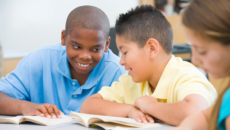By the time our children are in grade school, they know that their adoption story involves a separation from birth parents and, possibly, has meant a major move from one state or country to another. Because moving involves separation and loss, a family relocation may bring up new worries and concerns.
Fear of the Unknown
Sometimes these concerns surprise parents, as when a child in an open adoption wonders whether he’ll ever see his birth mother again, or when a grade-schooler worries that he’ll have to leave all of his toys behind. Six-year-old Jorge, for instance, was adopted from Guatemala as a baby. His mother recalls how he clung to an old blanket and cried when he left his Guatemalan foster family. Now that Jorge and his family are moving to a new neighborhood, he repeatedly asks whether his toys will come, too.
Lillian, age eight, anticipates a different kind of loss. Even though she was adopted domestically at birth, she still clings to safe, familiar surroundings. Lillian’s biggest concern is leaving school friends behind—kids who know her for who she is and with whom she’s shared parts of her adoption story.
Soothing Fears
Moving can be stressful for all family members. So before you get into the throes of packing, talk with your child and find out what’s really bothering him. Often, simple reassurances can separate past, internalized worries from concerns about the future.
For instance, if your child is in an open adoption, explain how he’ll continue to have contact with his birth mother through phone calls or letters. If he’s afraid of losing his toys (or other cherished possessions), assure him that they’ll come along. As Jorge’s mother told him, “You know, Jorge, there was a time when you did leave all your toys behind, when you left Guatemala as a baby. But this move will be different. You will take everything with you—including your toys and your parents.”
In Lillian’s case, her mother acknowledged that the move would not be easy. But she assured her that the family would make a plan to protect her privacy. They would think up different ways to answer difficult or intrusive questions. Above all, Lillian would not have to share her adoption story with new classmates or friends until she was ready.
Apart from these concerns, a move can mean other losses. Perhaps the family pet can’t come with you, or the old familiar couch has to go to Goodwill. Make a plan to say good-bye to these things in a way that brings closure for your child. For example, take photographs of the items and make a little book. Or, if possible, visit the pet’s new home a few weeks after moving.



